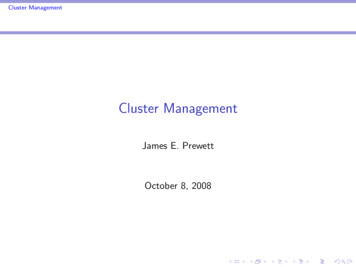
Transcription
Linux Networking ExplainedLinuxCon 2016, TorontoThomas Graf (@tgraf )Kernel, Cilium & Open vSwitch TeamNoiro Networks (Cisco)
Did you catch part I? Part II: LinuxCon, Toronto, 2016Linux Networking ExplainedNetwork devices, Namespaces, Routing, Veth, VLAN, IPVLAN, MACVLAN,MACVTAP, Bonding, Team, OVS, Bridge, BPF, IPSec Part I: LinuxCon, Seattle, 2015Kernel Networking WalkthroughThe protocol stack, sockets, offloads, TCP fast open, TCP small queues,NAPI, busy polling, RSS, RPS, memory accountinghttp://goo.gl/ZKJpor
Network Devices Real / PhysicalBacked by hardwareExample: Ethernet card,WIFI, USB, . Software / VirtualSimulation or virtualrepresentationExample: Loopback (lo),Bridge (br), Virtual Ethernet(veth), . ip link[.] ip link show enp1s0f14: enp1s0f1: NO-CARRIER,BROADCAST,MULTICAST,UP mtu 1500 qdisc mq state [.]link/ether 90:e2:ba:61:e7:45 brd ff:ff:ff:ff:ff:ff
AddressesDo we need to consider a packet for local sockets?Socketsip output()ip local deliver()Local?ip forward()Routingnet.ipv4.conf.all.forwarding 1 ip addr add 192.168.23.5/24 dev em1 ip address show dev em12: em1: BROADCAST,MULTICAST,UP,LOWER UP mtu 1500 qdisc fq codel state UP [.]link/ether 10:c3:7b:95:21:da brd ff:ff:ff:ff:ff:ffinet 192.168.23.5/24 brd 192.168.23.255 scope global em1valid lft forever preferred lft foreverinet6 fe80::12c3:7bff:fe95:21da/64 scope linkvalid lft forever preferred lft forever
Pro Tip: The Local TableList all accepted local addresses: ip route list table local type local127.0.0.0/8 dev lo proto kernel scope host src 127.0.0.1127.0.0.1 dev lo proto kernel scope host src 127.0.0.1192.168.23.5 dev em1 proto kernel scope host src 192.168.23.5192.168.122.1 dev virbr0 proto kernel scope host src 192.168.122.1H4x0r Tip: You can also modify this table after the generatedlocal routes have been inserted.
RoutingDeviceSocketsDeviceDeviceDirect Route - endpoints are direct neighbours (L2) ip route add 10.0.0.0/8 dev em1 ip route show10.0.0.0/8 dev em1 scope linkNexthop Route - endpoints are behind another router (L3) ip route add 20.10.0.0/16 via 10.0.0.1 ip route show20.10.0.0/16 via 10.0.0.1 dev em1
Pro Trick: Simulating a Route LookupHow will a packet to 20.10.3.3 get routed? ip route get 20.10.3.320.10.3.3 via 10.0.0.1 dev em1cachesrc 192.168.23.5NOTE: This is not just (ip route show grep). It performs anactual route lookup on the specified destination address in thekernel.
Network NamespacesLinux maintains resources and data structures per namespaceNamespace 1AddressesNamespace 2SocketsAddressesRoutesRoutestap0eth0SocketsNOTE: Not all data structures are namespace aware yet! ip netns add blue ip link set tap0 netns blue ip netns exec blue ip address1: lo: LOOPBACK mtu 65536 qdisc noop state DOWN group default qlen 1link/loopback 00:00:00:00:00:00 brd 00:00:00:00:00:0019: tap0: BROADCAST,MULTICAST mtu 1500 qdisc noop state DOWN group default qlen 1000link/ether 42:ad:d0:10:e0:67 brd ff:ff:ff:ff:ff:ff
VLANVirtual Networks on Layer 2Virtual Network 1VLAN1Virtual Network 2VLAN2Virtual Network 3VLAN3VLAN1L2VLAN2VLAN3Packet Headers:EthernetVLANIP ip link add link em1 vlan1 type vlan id 1 ip link set vlan1 up ip link show vlan115: vlan1@em1: BROADCAST,MULTICAST,UP,LOWER UP mtu 1500 qdisc noqueue state UP [.]link/ether 10:c3:7b:95:21:da brd ff:ff:ff:ff:ff:ff
Bonding / TeamLink Aggregation Uses:– Redundant network cards(failover)– Connect to multiple ToR (LB)Implementations:– Team (new, user/kernel)– Bonding (old, kernel only)team0 cp /usr/share/doc/teamd-*/example configs/activebackup ethtool 1.conf . teamd -g -f activebackup ethtool 1.conf -d[.] teamdctl team0 state[.]
VethVirtual Ethernet Cable Bidirectional FIFOOften used to cross namespaces ip link add veth1 type veth peer name veth2 ip link set veth1 netns ns1 ip link set veth2 netns ns2Namespace 1veth0Namespace 2veth1
BridgeVirtual Switch Flooding: Clone packets and sendto all ports.Learning: Learn who's behindwhich port to avoid floodingSTP: Detect wiring loops anddisable portsNative VLAN integrationOffload: Program HW based on FDBtableipipipiplinklinklinklinkaddsetsetsetbr0 type bridgeeth0 master br0tap3 master br0br0 upbr0portportport
ExampleBridge Team ner BNamespaceContainer Aeth0eth0eth1eth0
MACVLANSimplified bridging for guests NOT 802.1Q VLANsMultiple MAC addresses on single interfaceKISS - no learning, no STPModes:– VEPA (default): Guest to guest done onToR, L3 fallback possible– Bridge: Guest to guest in software– Private: Isolated, no guest to guest– Passthrough: Attaches VF al Device ip link add link em1 name macvlan0 type macvlan mode bridge ip -d link show macvlan023: macvlan0@em1: BROADCAST,MULTICAST mtu 1500 qdisc noop state DOWN [.]link/ether f2:d8:91:54:d0:69 brd ff:ff:ff:ff:ff:ff promiscuity 0macvlan mode bridge addrgenmode eui64 ip link set macvlan0 netns blue
ExampleTeam MACVLANNamespaceHostteam0NamespaceContainer Aeth0(macvlan)eth0eth1NamespaceContainer Beth0(macvlan)
TUN/TAPA gate to user space Character Device in user spaceNetwork device in kernel spaceL2 (TAP) or L3 (TUN)Uses: encryption, VPN, tunneling,virtual machines, .userkernelFileDescriptorFileDescriptortun0tap0 ip tuntap add tun0 mode tun ip link set tun0 up ip link show tun018: tun0: NO-CARRIER,POINTOPOINT,MULTICAST,NOARP,UP mtu 1500 qdisc fq codel [.]link/none ip route add 10.1.1.0/24 dev tun0user.c:fd open("/dev/net/tun", O RDWR);strncpy(ifr.ifr name,“tap0”, IFNAMSIZ);ioctl(fd, TUNSETIFF, (void *) &ifr);
MACVTAPBridge TAP MACVTAP A TAP with an integrated bridgeConnects VM/container via L2Same modes as vtap3MAC2Physical Device ip link add link em1 name macvtap0 type macvtap mode vepa ip -d link show macvtap20: macvtap0@em1: BROADCAST,MULTICAST,UP,LOWER UP mtu 1500 qdisc fq codel state UP [.]link/ether 3e:cb:79:61:8c:4b brd ff:ff:ff:ff:ff:ffmacvtap mode vepa addrgenmode eui64 ls -l /dev/tap20crw-------. 1 root root 241, 1 Aug 8 21:08 /dev/tap20
IPVLANMACVLAN for Layer 3 (L3) Can hide many containers behind asingle MAC address.Shared L2 among slavesMode:– L2: Like MACVLAN w/ single MAC– L3: L2 deferred to masternamespace, no multicast/broadcastipipipipipnetns add bluelink add link eth0link set dev ipvl0netns exec blue ipnetns exec blue ipslavesmasteripvl0 type ipvlan mode l3netns bluelink set dev ipvl0 upaddr add 10.1.1.1/24 dev ipvl0ipvlan0ipvlan1IP1IP2Physical Device
MACVLAN vs IPVLANMACVLAN– ToR or NIC may havemaximum MAC addresslimit– Doesn't work well with802.11 (wireless)IPVLAN– DHCP based on MACdoesn't work, must useclient ID– EUI-64 IPv6 addressesgeneration issues– No broadcast/multicastin L3 mode
Encapsulation (Tunnels)Virtual Networks on Layer 3/4Virtual Network 1vxlan1Virtual Network 2vxlan2Virtual Network 3vxlan3vxlan1L3/L4vxlan2vxlan3VXLAN Headers rlay ip link add vxlan42 type vxlan id 42 group 239.1.1.1 dev em1 dstport 4789 ip link set vxlan42 up ip link show vxlan4231: vxlan42: BROADCAST,MULTICAST,UP,LOWER UP mtu 1450 qdisc noqueue state UNKNOWN [.]link/ether e6:fc:c8:7e:07:83 brd ff:ff:ff:ff:ff:ff
IPSecAuthenticated &EncryptedSocketSocketNetdeviceL3Transport ModeEthernet IPESPTCP Tunnel ModeEthernetIPESPIPNetdeviceAH: AuthenticationESP: Authenication encryptionTCP ip xfrm state add src 192.168.211.138 dst 192.168.211.203 proto esp \spi 0x53fa0fdd mode transport reqid 16386 replay-window 32 \auth "hmac(sha1)" 0x55f01ac07e15e437115dde0aedd18a822ba9f81e \enc "cbc(aes)" 0x6aed4975adf006d65c76f63923a6265b \sel src 0.0.0.0/0 dst 0.0.0.0/0
Fully programmable L2-L4 virtualswitch with APIs: OpenFlow andOVSDBSplit into a user and kernel componentMultiple control plane integrations:– OVN, ODL, Neutron, CNI, Docker, . ovs-vsctl add-br ovs0 ovs-vsctl add-port ovs0 em1 ovs-ofctl add-flow ovs0 in port 1,actions drop ovs-vsctl showa425a102-c317-4743-b0ba-79d59ff04a74Bridge "ovs0"Port "em1"Interface "em1"[.].ovs0portportport
BPFSourceCodeLLVM/clangByteCodeUserspaceVerifier JITKernelSocketsadd eax,edxshl eax,2netdeviceTCIngressadd eax,edxshl eax,2NetworkStackTCEgressAttaching a BPF program to eth0 at ingress: clang -O2 -target bpf -c code.c -o code.otc qdisc add dev eth0 clsacttc filter add dev eth0 ingress bpf da obj code.o sec my-section1tc filter add dev eth0 egress bpf da obj code.o sec my-section2netdevice
BPF Features(As of Aug 2016) Maps– Arrays (per CPU), hashtables (per CPU)Packet manglingRedirect to other deviceTunnel metadata (encapsulation)Cgroups integrationEvent notifications via perf ring buffer
XDP – Express Data PathSourceCodeLLVM/clangByteCodeUserspaceVerifier JITAccess toDMA bufferSocketsadd eax,edxshl eax,2DriverNetdeviceNetworkStackKernel
Q&ALearn more about networking with BPF:Fast IPv6-only Networking for Containers Based onBPF and XDPWednesday August 24, 2016 4:35pm – 5:35pm, Queen's QuayContact: Twitter: @tgrafImage Sources: Cover (Toronto)Rick Harris (https://www.flickr.com/photos/rickharris/)The Invisible ManDr. Azzacov OHN LLOYD (https://www.flickr.com/photos/hugo90/)Mail: tgraf@tgraf.ch
Pro Tip: The Local Table ip route list table local type local 127.0.0.0/8 dev lo proto kernel scope host src 127.0.0











